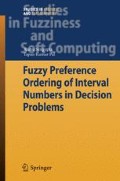Introduction
The problems of distribution of goods from manufacturer to customer are generally described under a common heading, Transportation Problem (TP). The TP, originally developed by Hitchcock (1941), can be used when a firm tries to decide where to locate a new facility. Good financial decisions concerning facility location also attempt to minimize total transportation and production costs for the entire system. Moreover, there are many problems not exactly being called the TP but can be modelled alike.
Access this chapter
Tax calculation will be finalised at checkout
Purchases are for personal use only
Preview
Unable to display preview. Download preview PDF.
References
Y.P. Aneja & K.P.K. Nair (1979), Bi-criteria Transportation Problems, Management Science 25: 73 – 78.
K. Asai & H. Tanaka (1984), Fuzzy linear programming with fuzzy numbers, Fuzzy Sets and Systems 13 (1): 1 – 10.
G.R. Bitran (1980), Linear multiobjective problems with interval coefficient, Management Science 26: 694 – 706.
S. Chanas & D. Kuchta (1996a), A concept of solution of the Transportation Problem with fuzzy cost coefficient, Fuzzy Sets and Systems 82 (3): 299 – 305.
S. Chanas & D. Kuchta (1996b), Multiobjective programming in optimization of interval objective functions – A generalized approach, European Journal of Operational Research 94 (3): 594 – 598.
S. Chanas & D. Kuchta (1998), Fuzzy integer transportation problem, Fuzzy Sets and Systems 98 (3): 291 – 298.
J.W. Chinneck & K. Ramadan (2000), Linear programming with interval coefficients, Journnal of the Operational Research Society 51 (2): 209 – 220.
J.N. Climaco, C.H. Antunes & M.J. Alves (1993), Interactive decision support for multiobjective transportation problems, European Journal of Operational Research 65 (1): 58 – 67.
J. Current & M. Marsh (1993), Multiobjective transportation network design and routing problems: Taxonomy and annotation, European Journal of Operational Research 65 (1): 4 – 19.
J. Current & H. Min (1986), Multiobjective design of transportation networks: Taxonomy and annotation, European Journal of Operational Research 26 (2): 187 – 201.
S.K. Das, A. Goswami & S.S. Alam (1999), Multiobjective transportation problem with interval cost, source and destination parameters, European Journal of Operational Research 117 (1): 100 – 112.
Silvio Giove (2002), Interval TOPSIS for Multicriteria Decision Making, in: M. Marinaro & R. Tagliaferri (Eds.): WIRN VIETRI 2002, Lecture Notes in Computer Science 2486, Springer-Verlag Berlin Heidelberg: 56-63.
F.L. Hitchcock (1941), The distribution of a product from several sources to numerous localities, Journal of Mathematical Physics 20: 224 – 230.
M. Inuiguchi & Y. Kume (1991), Goal Programming problem with Interval Coefficients and Target Intervals, European Journal of Operational Research 52 (3): 345 – 360.
H. Isermann (1979), The enumeration of all efficient solutions for a Linear Multiobjective Transportation Problem, Naval Research Logistic Quarterly 26: 123 – 139; Fuzzy Sets of Systems 18 (1986): 15 – 30.
H. Ishibuchi & H. Tanaka (1990), Multiobjective programming in optimization of the interval objective function, European Journal of Operational Research 48 (2): 219 –225.
S. Karmakar & P.P. Mujumdar (2005), Grey Fuzzy Multiobjective Optimization Model for River Water Quality Management, Proc. of International Conference on Hydrological Perspectives for Sustainable Development (HYPESD - 2005): 923-931, IIT Roorkee, India. (Available online: http: //eprints.iisc.ernet.in /archive/ 00003153/01/Karmakar_Mujumdar_ HYPESD_2005.pdf).
S. Kundu (1997), Min-transitivity of fuzzy leftness relationship and its application to decision making, Fuzzy Sets and Systems 86 (3): 357–367.
S. Okada & M. Gen (1994), Order Relation between Intervals and Its Application to Shortest Path Problem, Japanese journal of Fuzzy Theory and Systems 6 (6): 703 – 717 (In English).
C. Oliveira & C.H. Antunes (2007), Multiple objective linear programming models with interval coefficients – an illustrated overview, European Journal of Operational Research 181: 1434–1463.
J.L. Ringuest & D.B. Rinks (1987), Interactive solutions for the Linear Multiobjective Transportation Problem, European Journal of Operations Research 32 (1): 96 – 106.
A. Sengupta, T.K. Pal & D. Chakraborty (2001), Interpretation of inequality constraints involving interval coefficients and a solution to interval linear programming, Fuzzy Sets and Systems 119 (1): 129 – 138.
A. Sengupta & T.K. Pal (2003), Interval-valued transportation problem with multiple penalty factors, VU Journal of Physical Sciences 9: 71 – 81.
A. Sengupta & T.K. Pal (2004), Decision Maker’s Pessimistic / Optimistic Bias in an Interval-valued Transportation Problem, e-Proceedings of the First World Congress on Lateral-Computing (WCLC 2004), Bangalore, India.
A.L. Soyster (1979), Inexact Linear Programming with Generalized Resource Sets, European Journal of Operational Research 3: 316-321.
R.E. Steuer (1981), Algorithm for linear programming problems with interval objective function coefficient, Mathematics of Operations Research 6: 333 – 348.
S. Tong (1994), Interval number and fuzzy number linear programming, Fuzzy Sets and Systems 66: 301–306.
N. Yorke-Smith & C. Gervet (2001), Data uncertainty in constraint programming: a non-probabilistic approach, American Association for Artificial Intelligence 2001 Fall Symposium, November 2-4, 2001. (Available online: http: //www-users.cs.york.ac.uk/~tw/fall /Proceedings/yorke.pdf).
Rights and permissions
Copyright information
© 2009 Springer-Verlag Berlin Heidelberg
About this chapter
Cite this chapter
Sengupta, A., Pal, T.K. (2009). Interval Transportation Problem with Multiple Penalty Factors. In: Fuzzy Preference Ordering of Interval Numbers in Decision Problems. Studies in Fuzziness and Soft Computing, vol 238. Springer, Berlin, Heidelberg. https://doi.org/10.1007/978-3-540-89915-0_7
Download citation
DOI: https://doi.org/10.1007/978-3-540-89915-0_7
Publisher Name: Springer, Berlin, Heidelberg
Print ISBN: 978-3-540-89914-3
Online ISBN: 978-3-540-89915-0
eBook Packages: EngineeringEngineering (R0)

